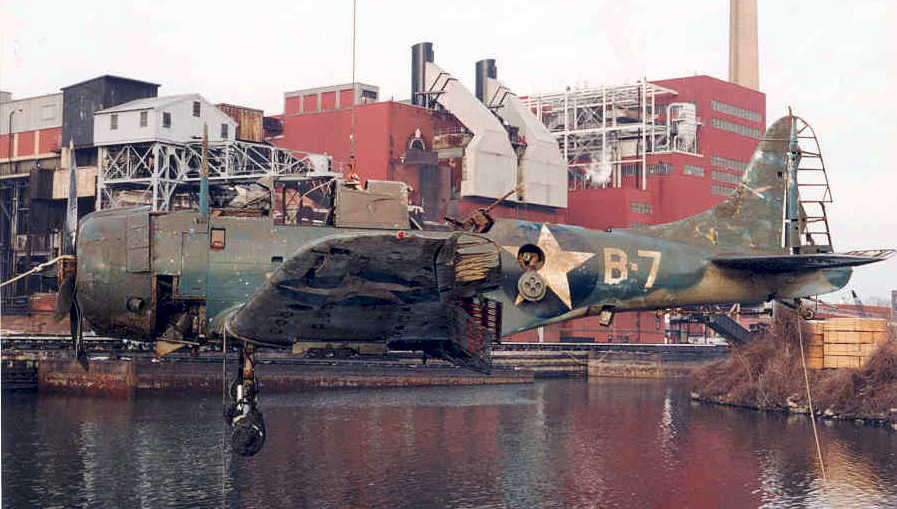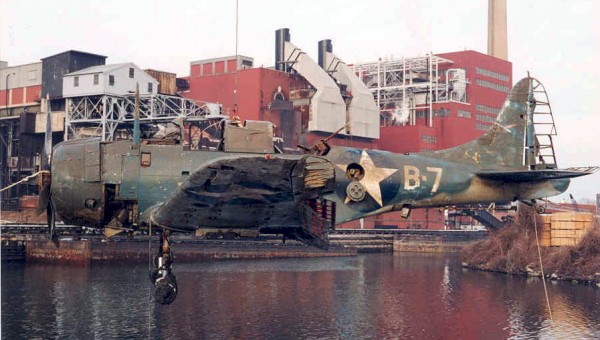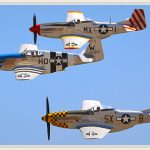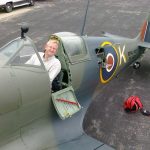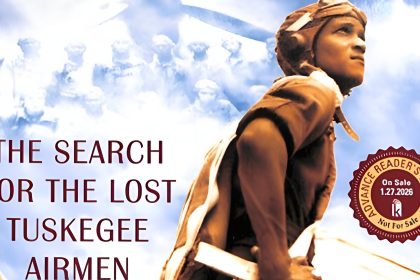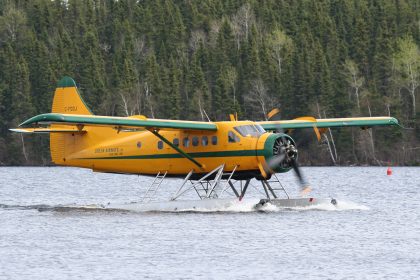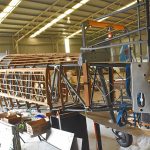Warbirds News has learned that the Museum of Flight in Seattle, Washington will be holding be holding a two-day symposium on aviation archeology over the weekend of March 15th/16th. Titled “Before It’s Too Late”, this conference is bound to be a fascinating experience as it will cover every aspect of the emerging science from the countless hours of detailed research often involved in locating the wreck, to the frequently adventurous tales of recovery or indeed the preservation of the crash-site. The weekend will bring together some of the foremost authorities in the field from Taras Lyssenko, well-known salvor of sunken warbirds, to noted author and researcher, Nick Veronico. Go beyond the break to find out more…
According to the Museum of Flight’s website, the presentation schedule will be as follows…
Saturday, March 15th:
“8:30 a.m. – Remote presentation with Ian Thirsk from the Royal Air Force Museum in England. Ian Thirsk, from the Royal Air Force Museum will be discussing the recovery of the world’s only surviving Dornier Do 17. After more than 70 years under water, a successful recovery effort raised the rare bomber from the bottom of the English Channel in June of 2013. The team from the RAFM in Cosford, England will share their story about the discovery, recovery, and conservation of the Dornier Do 17.
9:30 a.m. – Studying Sunken Wings: Megan Lickliter-Mundon (Texas A&M Grad student) provides An Introduction to Underwater Aviation Archaeology. Everyone knows that Indiana Jones went to the Temple of Doom, but what about underwater to find sunken vintage aircraft? Archaeologists are constantly exploring new ways to understand and preserve our history. Using archaeological methods to discover, document, and conserve aircraft that come from under water adds an incredible amount of information to our knowledge base. For anyone who wants to know what aviation archaeology is, what sorts of projects there have been recently, what information archaeologists learn, and what we use it to do- this presentation is for you!
10:50 a.m. – Mark Allen and Robert Mester of Underwater Admiralty Sciences will detail the concerted recovery effort of a Douglas A-20 Havoc from a swampy bog near the Boreal forest near Goose Bay Labrador.
1:10 p.m. – Lake Michigan WWII Aircraft Recoveries, Archaeology and Beyond with John Dorwin (EWU Professor, A&T RecoveryArchaeologist).
2:30 p.m. – The War Birds of Lake Michigan with Taras Lyssenko of A&T Recovery. Twenty-five years ago A&T Recovery surveyed much of the floor of the southern basin of Lake Michigan in order to locate the aircraft lost during the aircraft qualification training that had been conducted during World War II. Using this knowledge the Director of the National Naval Aviation Museum launched an ambitious project to retrieve many of the aircraft on behalf of the people of the United States of America. The presentation takes an in-depth look at the project.
Mr. Taras Lyssenko, the “T” of A&T Recovery, has worked locating and recovering the lost Navy airplanes of Lake Michigan for the past 25 years. He has retrieved nearly four dozen aircraft that are now on display in museums across the country. Taras has a unique perspective of the aircraft produced and used by the Greatest Generation to preserve our freedom/liberty and of the project to preserve the history for present and future generations.
Sunday, March 16th:
9:00 a.m. –The Duck Hunt: Recovery of a Grumman Duck from Greenland with John Sessions of Historic Flight Foundation. In 1942 a U.S. Coast Guard amphibious biplane crashed into a glacier in eastern Greenland with 3 men aboard. All perished. The plane was in the midst of a daring rescue of the crew of a B-17 that had crashed a couple weeks previously. Now, 70 years later, a team of private explorers, U.S. Coast Guard personnel, and Department of Defense anthropologists have resumed the search for this plane and the brave men who died in service to their country. This presentation will also feature Nicholas Bratton, who served as Safety Team Leader for the expedition.
9:45 a.m. – P-51B “Impatient Virgin” Recovery. In a recovery effort that took three years to complete, the Historic Flight Foundation’s rare B model Mustang was successfully recovered from the English beet field in which it crashed in 1944. John Sessions will discuss this recovery and restoration effort, and as an added bonus (weather permitting, fingers crossed!), will have “Impatient Virgin” on-site at the Museum of Flight during the symposium.
10:30 a.m. – Echoes of Thunder: Aerospace Archeology with Peter Merlin and Tony Moore (X-Hunters). Known as “The X-Hunters,” Peter Merlin and Tony Moore have located more than 100 crash sites of historic aircraft from Edwards Air Force Base and Area 51. At these sites, they have discovered parts of supersonic rocket planes, stealthy spy craft, and experimental vehicles that flew to the edge of space. Searching for the final resting places of these exotic craft combines C.S.I.-type skills and X-Files persistence, with a dash of Indiana Jones adventure.
Peter W. Merlin has studied and documented aerospace accidents, incidents, and crash sites for more than 25 years. He is the author of numerous books including X-Plane Crashes (Specialty Press, 2008), Breaking The Mishap Chain (NASA, 2012), and Crash Course: Lessons Learned from Accidents and Incidents Involving Remotely piloted and Autonomous Aircraft (NASA, 2013). He has also appeared on television documentaries for the History Channel, Discovery, National Geographic, and the Travel Channel. Merlin is a member of the Flight Test Historical Foundation, Nevada Test Site Historical Foundation, National Atomic Museum Foundation, and an associate member of Roadrunners Internationale.
11:50 a.m. – Dr. Adrian Hunt, Eecutive Director of Flying Heriage Collection in Everett, WA.
2:00 p.m. – Nicholas Veronico, author of “Hidden Warbirds: The Epic Stories of Finding, Recovering & Rebuilding WWII’s Lost Aircraft.“ Mr. Veronico got his start in aviation journalism as a freelance journalist in 1984, then joined Pacific Flyer Aviation Newspapers. He then went on to serve as editor of In Flight USA, contributed extensively to FlyPast magazine, and in 1994 joined Airliners: The World’s Airline Magazine. On a freelance basis, he has contributed to Air Classics, EAA Warbirds, Warbirds Worldwide, Airliner World, Classic Wings, and many others.
3:10 p.m. – Dave Goss of GossHawk Unlimited. Born into an Air Force family, Dave Goss realized his love for aviation at an early age. His father served as a navigator/bombardier on B-17′s and as a navigator in Lockheed C-130′s. Dave enlisted in the United States Army, and served in Vietnam as a gunner/crew chief in helicopters. After completing his tour in Vietnam, Dave served out the terms of his enlistment in Germany as a helicopter mechanic; it seemed a natural step that Dave take what he learned in the Army, and apply it to his civilian life. When he arrived home from Germany, Dave enrolled in Embry-Riddle University’s Maintenance and Technology program. Dave received his A&P license, and from there he began his career in aviation. His first job was overhauling Pratt and Whitney J-57 and TF-30 jet engines at Naval Air Rework Facility (NARF) in Norfolk, Virginia. After three years of working on jet engines, Dave went to work on de Havilland Caribous and Lockheed Electras in Kwajalein in the Marshall Islands. Dave moved to Arizona and enrolled in the Aeronautical Engineering Technology program at Arizona State University. While attending ASU he met the people at the Champlin Fighter Museum in Mesa, Arizona and went to work for them as a mechanic in 1983 working on WWI, WWII, Korean and Vietnam era aircraft. Eventually Dave rose to the position of General Manager of the Champlin Fighter Museum. In May of 1995, Dave Goss started GossHawk Unlimited with only one employee, and he used the former Champlin Fighter Museum’s restoration hangar as his shop. Dave Goss’s knowledge and attention to detail in the restoration of vintage aircraft is second to none, and has earned him a reputation as a leader in the aircraft restoration industry.”
Admission for the symposium is $20 for both days ($15 for Museum Members). Space is limited though, and advance tickets are available at Museumtix.
With thanks to the marvelous Museum of Flight.







